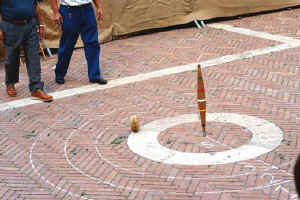
Cacio al Fuso |

The pecorino and the spindle |
|
Pienza is famous not only for its architectures but also for the excellent sheep's milk cheese, or more correctly, ewes' milk cheese, pecorino, produced in the area. The word "formaggio" - generic cows' milk cheese - is rarely used in Tuscany where most of the cheese consumed is pecorino, followed in popularity by mozzarella and then other cheeses that have their own individual names. Even the word "pecorino", alluding to "pecora" - a ewe - is a quite recent invention. Until the end of World War II, Tuscans used the term "cacio", and indeed the cheese rolling competition held in Pienza on the first Sunday of September is know as "cacio al fuso" - literally, the cheese to the spindle. The aim of the participants in this popular festival is to see who can roll the cheese so that it stops closest to the spindle. |
|
Pecorino
is sold fresh, medium-aged and mature. It doesn't get better as it ages, it
simply changes in flavour and consistency, and which one you prefer is purely a
matter of personal taste. Regional varieties of pecorinoPecorino ToscanoA variety that is often eaten fresh is known as Pecorino Toscano and is made in Tuscany. It has a whiter colored paste that is creamier in texture, providing a somewhat nutty flavour. Versions of this cheese are also made with cows' milk, which can typically be detected by the yellowish tint to the cheese. However, under recent laws, a cheese marketed as pecorino must now be made 100% from ewes' milk. Another Tuscan pecorino is the Pecorino Senese or Senesi, which is a cheese that has a reddish rind due to the rind being rubbed with tomato paste. In years past, the rind was rubbed with sheep blood to obtain the red colour. The pecorino of Pienza is very highly regarded, the taste coming both from the types of grass and herbs consumed by the sheep, and the manufacturing techniques. Pecorino RomanoA popular mature pecorino is Pecorino Romano, which has a hard yellow rind with a yellowish white interior. This cheese is typically aged for 8 months to a year before being eaten. It has a sharp flavour, and is best consumed thinly sliced. It can also be grated although most pecorinos are not suitable for grating. Pecorino Sardo The pecorino of Sardinia is becoming increasingly popular both because it costs less than mainland pecorino and because of its excellent taste. Redentore, a Sardinian pecorino is soft and greenish in colour. Pecorino Siciliano Pecorino from Sicily - Picurinu Sicilianu in Sicilian dialect include canestrato (sometimes called incanestrato) and pepato. Canestrato is a made by placing the cheese curds in baskets where the whey is drained off as the curds bond together with the irregular shape of the basket weave forming the shape of the outer rind. Aged for up to 6 months the cheese is sold as a young cheese while the sharper and more aromatic cheeses aged for up to a year are sold as grating or slivered snacking cheese with meats, breads, and over pasta. The Sicilian Pepato is a variety of Pecorino that has black peppercorns added to the paste of the cheese to enhance the flavour. Available as fresh or an aged cheese, Pecorino Pepato has a flavor that is mildly salty and peppery that becomes spicier with age. As it ages, this cheese becomes a good cheese for grating to be used for baked potatoes, grilled vegetables such as corn on the cob, or for pasta dishes. How to eat pecorinoPecorino should be taken out of the refrigerator about an hour before being eaten, in order to let it regain its natural softness and to open up its taste. It is excellent when flavoured with some good olive oil. Pecorino can also be served as a dessert cheese, with honey dripped onto a very thin slice but this is not a particularly successful combination. Since the mature pecorino is much sharper tasting, it is generally sliced into thin shavings to be eaten alone or with sliced cured meats. |
|
Pienza © ammonet InfoTech 2000 - 2020. All rights reserved.